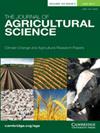Examining the Predatory Relationship Between the Indigenous Firefly (Aspisoma ignitum) and the Invasive Giant African Snail (Achatina fulica) in Trinidad, West Indies
IF 1.7
4区 农林科学
Q2 AGRICULTURE, MULTIDISCIPLINARY
引用次数: 0
Abstract
The current study investigates the predatory relationship between the firefly larvae (Aspisoma ignitum) and the giant African snail (Achatina fulica). The principal objective of this study was to examine the specific predator responsiveness of the firefly larvae against the giant African snails under experimental conditions. This was evaluated using two (2) treatments T1 and T2. T1 investigated giant African snail neonates of size 0.5 cm with a larva to snail ratio of 1:5. In T2, larvae to snail ratio of 3:1 was investigated using 2 cm giant African snail neonates. Control treatments were included in the experimental design with the absence of the larvae. Each treatment was replicated five (5) times. There were 100 % mortality effects for T1 and T2. Commonalities existed in both the spatial and the temporal characteristics to possibly consider the firefly larvae as an idealistic and highly compatible predator for the giant African snail neonates. Ecological engineering strategies to encourage the presence of the firefly will aid in suppressing the giant African snail population. The study concludes that the firefly larvae can be a possible predator for the control of the giant African snail once the firefly populations are encouraged in both crop and non-crop spaces.西印度群岛特立尼达的本土萤火虫(Aspisoma ignitum)与入侵的非洲巨型蜗牛(Achatina fulica)之间的捕食关系研究
本研究探讨了非洲大蜗牛(Achatina fulica)与萤火虫幼虫(Aspisoma ignitum)的捕食关系。本研究的主要目的是在实验条件下研究萤火虫幼虫对非洲巨型蜗牛的特异性捕食反应。采用T1和T2两种治疗方法对其进行评估。T1研究了体型为0.5 cm的非洲巨型蜗牛幼仔,幼虫与蜗牛的比例为1:5。T2以2 cm的非洲巨螺幼螺为研究对象,以3:1的比例研究幼虫与螺的比例。在实验设计中加入不含幼虫的对照处理。每个处理重复5次。T1和T2的死亡率为100%。萤火虫幼虫在空间和时间特征上存在共性,可能是非洲巨蜗牛幼仔理想的、高度相容的捕食者。鼓励萤火虫存在的生态工程策略将有助于抑制巨型非洲蜗牛的数量。该研究的结论是,一旦在作物和非作物空间鼓励萤火虫的数量,萤火虫的幼虫可能成为控制巨型非洲蜗牛的捕食者。
本文章由计算机程序翻译,如有差异,请以英文原文为准。
求助全文
约1分钟内获得全文
求助全文
来源期刊

Journal of Agricultural Science
农林科学-农业综合
CiteScore
2.80
自引率
5.00%
发文量
68
审稿时长
1.4 months
期刊介绍:
The Journal of Agricultural Science publishes papers concerned with the advance of agriculture and the use of land resources throughout the world. It publishes original scientific work related to strategic and applied studies in all aspects of agricultural science and exploited species, as well as reviews of scientific topics of current agricultural relevance. Specific topics of interest include (but are not confined to): all aspects of crop and animal physiology, modelling of crop and animal systems, the scientific underpinning of agronomy and husbandry, animal welfare and behaviour, soil science, plant and animal product quality, plant and animal nutrition, engineering solutions, decision support systems, land use, environmental impacts of agriculture and forestry, impacts of climate change, rural biodiversity, experimental design and statistical analysis, and the application of new analytical and study methods (including genetic diversity and molecular biology approaches). The journal also publishes book reviews and letters. Occasional themed issues are published which have recently included centenary reviews, wheat papers and modelling animal systems.
 求助内容:
求助内容: 应助结果提醒方式:
应助结果提醒方式:


